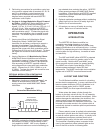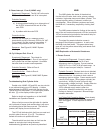
This feature will reduce the possibility of corrosion
of the electrodes and the possible accumulation of
algae and bacteria growing in the cylinder.
BUILT ON AND REMOTE MOUNTED
BLOWER PACKS (BOBP’s / RMBP’s)
FAN MOTOR OILING: The blower pack fan motor
requires occasional oiling of motor bearings. To do
this, open up the blower pack top and oil the motor
with ten drops of SAE-20 grade motor oil. Refer to
Figure #6 for oiling slots. It is important to oil the fan
motor every four months to preserve long life and to
maintain the fan’s warranty. It is not necessary to
disassemble the fan/motor assembly. The exploded
view is for visual purposes only.
TROUBLESHOOTING
PLEASE READ THIS SECTION BEFORE
REFERENCING SPECIFIC DIAGNOSTIC
MESSAGES.
1. Ensure the installation detail conforms with the
recommendations contained in the Installation
Manual, Form #XX-161.
2. Understanding the Principle of Operation is an
asset when troubleshooting. This information is
readily available from your local representative.
3. When contacting your local representative or
NORTEC, for troubleshooting assistance, please
ensure the serial number has been obtained for
reference purposes.
4. Whenever the troubleshooting steps indicate a
problem with the main pc-board, first check all
connections at the main pcb (including the ribbon
cable connections at the center of the main pcb)
before ordering replacements.
STARTING POINT
If nothing is working, check for 24 VAC output
from the stepdown transformer (see wiring diagram).
If there is no 24 VAC output, the transformer might
have been damaged if external controls were installed
and/or connected with the field-supplied fused
disconnect on. If this is the case, the transformer must
be replaced.
The conductivity of the water within the cylinder
must be controlled, in order for the humidifier to
function properly. The fill and drain rates must be
maintained. Filling too quickly can cause over-amping
and automatic shutdown or blown fuses. Filling too
slowly can cause insufficient steam output and
humidity levels. Water supply pressure should be
between 30 and 80 psig, ideally 55 to 60 psig.
Draining too slowly can cause over-concentration and
malfunction due to foaming. These are just some
examples of what can go wrong if the fill and drain
rates are not maintained.
Fill rates of suspect units should be checked.
Open the disconnect to cut off all power in the
humidifier before reaching inside. One of the 24VAC
wires to each primary voltage contactor holding coil
(some models have two contactors per cylinder)
should be temporarily disconnected for this test. This
way, no boiling occurs during the test so as not to
detract from the fill rate. Fill rates should measure
nominally at 1" to 1-1/2" of vertical rise in water level in
the cylinder in one minute.
If filling too quickly, check for excessively high
supply water pressure (over 80 psig). If water
pressure is correct, verify fill valve body orifice (consult
factory). If filling too slowly, look to probable causes
described under Error 3 later in this manual. Check
rate with steam line disconnected.
Manual drain rates of suspect units should be
checked using Figure #18 as reference times.
If time measurements are longer, repeat with
external drain disconnected (and draining into a pail)
to know if external drain is impeding flow.
Clogged strainer and/or clogged drain valve will
cause shortened cylinder life. But start by determining
what caused the strainer and/or drain valve to clog in
the first place.
Do not assume that if strainer and/or drain valve
are clogged that they are to blame. If the external
drain has been impeding flow, then waste
accumulates, resulting in a clogged strainer and/or
clogged drain which, in turn, results in shortened
cylinder life.
-15-
CYL. SIZE
(SERIES)
PROPER TIME (sec) TO DRAIN MANUALLY
FROM SEAM TO EMPTY
BEIGE BODY DRAIN VALVE
500/600 2 minutes and 52 seconds ± 10 sec.
400 1 minute and 20 seconds ± 5 sec.
300 43 seconds ± 2 sec.
200 25 seconds ± 1 sec.
Figure #18
Manual Drain Times


















